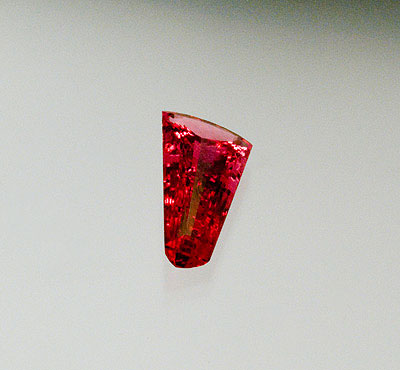gem-news-2009-v1

January – April 2009
- April 2009 Newsletter – Apr 16
- Recent March News – Mar 24
- March 2009 Newsletter – Mar 18
- Other March News – Mar 4
- February 2009 Newsletter – Feb 25
- January 2009 Newsletter – Jan 19
April 2009 Newsletter
Pala International News
Gem and Gemology News
Industry News
- AGL to Reopen
- Sotheby’s Hong Kong Sale
- Under the Drones: The Impact of Economic Recession on Miners and Dealers of Pakistan and Afghanistan
- Burma Bits
- Year-End Stats Show Leaps and Bounds for Foreign Investment, Trade, Surpluses, Gem Production
- Bite-Sized Bits
Pala International News
Pala’s Featured Stone: Aqua-marine
This month we feature a dazzling aquamarine. In the gem trade aquamarine most often refers to the blue variety of beryl, but the first element of this compound word actually implies some green. Even Webster’s Dictionary defines aqua as “a light greenish blue color.” Today most pure-blue aquamarines are heated from greenish blue rough; the heated process removes the secondary green hue and leaves only the blue hue.
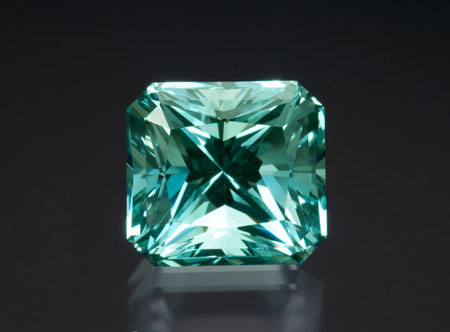 |
| A flawless 22-carat natural aquamarine with an exquisite radiant-style faceting. Inventory #15579. (Photo: Mia Dixon) |
Our featured aquamarine exhibits the beautiful blend of blue and green in its natural state. It’s reminiscent of open ocean water, which is of course implied by the second element of the word: marine. Major producers of gem-quality aquamarine today are Brazil, China, and several countries in Africa.
Interested? Select Inventory #15579, call, or email us to inquire. [back to top]
Larson to Speak at Sinkankas Symposium
Spotlight on Spinel
Bill Larson is slated to speak at this year’s seventh annual John Sinkankas Symposium, on the event’s sole topic: spinels. The symposium is sponsored by the San Diego Mineral and Gem Society and the Gemological Institute of America (details here).
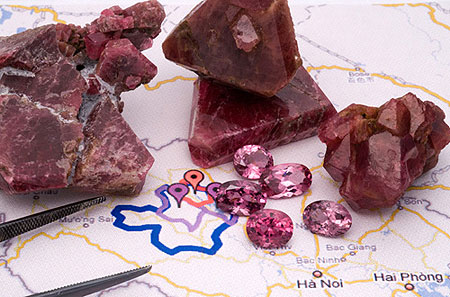 |
| Spinel, crystalline and cut. (Photo: Wimon Manorotkul) |
Bill’s extensive knowledge on spinels, from mine to market, will guide you through the five major spinel producing regions: from the historic deposits in the Pamir mountains of Tajikistan, to the diverse deposits around Burma, to the alluvial deposits of Sri Lanka, to the Luc Yen region of Vietnam, and finally the recent major find near Mahenge in Tanzania.
 |
| Violet spinel, 7.24 carats, from Mogok, Burma. Formerly in the Sinkankas collection, now in Bill Larson’s collection. (Photo: Wimon Manorotkul) |
In discussing these varied deposits Bill will incorporate geography, geology, mineralogy, and gemology. The talk will be accompanied by some current and colorful images of mining localities, rough crystals, faceted gems, and inclusions. As the International Colored Gemstone Association’s cover of last summer’s InColor states, “Like a phoenix—red spinel on the rise,” Bill will bring us all the history behind this very trendy and desired gemstone.
Other presenters scheduled are Si Frazier, Edward Boehm, Dr. William “Skip” Simmons, Dr. Jennifer Stone-Sundberg, Jo Ellen Cole, Meg Berry, Robert Weldon, John Koivula, and Dr. George Rossman, all of whom will be speaking in their area of expertise. [back to top]
Gem and Gemology News
Update on Mozambique Tourmalines
The complicated history of Mozambique cuprian "paraiba-like" tourmalines, by Mary L. Johnson, PhD
A new study by Dr. Mary L. Johnson examines the life of a tourmaline crystal in three stages to reveal the natural origin of the pink color around growth tubes, which we see in some of today’s faceted tourmaline from Mozambique. The study was distributed by the American Gem Trade Association, March 25.
In the initial stages of crystallization in a pegmatitic environment, the crystal grows from bottom to top and inside out. Varying amounts of trace elements, precipitated minerals, and phase-splits into liquid and gas, are a few of the events that can morph the character of the crystal. These external changes can cause internal changes in the form of color zoning, cracks and healed cracks or fingerprints, and incomplete growth along the C-axis causing long fibrous tubes or trichites.
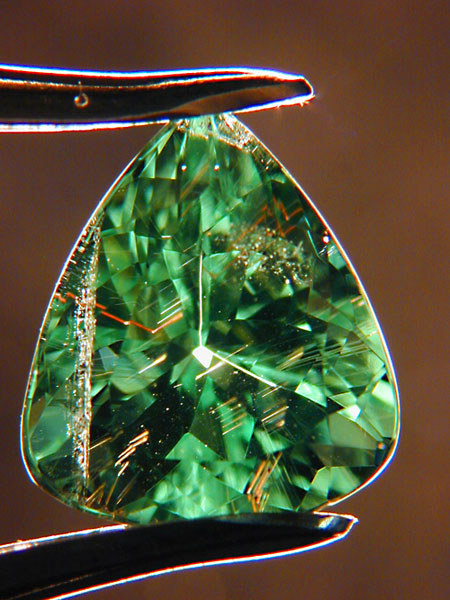 |
| Needlework. A 3.22-carat Mozambique paraiba tourmaline (9.5 x 8 x 5.4 mm) showing brick-colored growth tubes. (Photo: Jason Stephenson) |
The second stage involves the weathering, eroding, and ultimate etching of tourmaline crystals into worn pebbles and nodules. Then the cavities and hollow tubes are penetrated by the local soil and earth. The lateritic soils surrounding the tourmalines in Mozambique are rich in iron oxides, clay, and tiny quartz crystals. When these soils contain radioactive components and there is presence of manganese in the tourmaline crystal, pink halos can form around the hollow tubes.
The final stage is where Man comes in…collecting the worn and penetrated pebbles, cutting and polishing, and then the final heat treatment. Heat treatment will cause the imbedded soils to turn into a brick-like material—most likely the cause of the brick colored needles in the photo above.
GIA’s Spring 2009 edition of Gems & Gemology contains an article entitled “Solution-Generated Pink Color Surrounding Growth Tubes and Cracks in Blue to Blue-Green Copper-Bearing Tourmalines from Mozambique,” which deduces some very relevant findings on this issue as well.
Radiation has been historically and scientifically proven to produce pink-to-red discoloration in tourmaline. Pink coloration, or pink sleeves around the tubes, were only seen around growth tubes and cracks that reached the surface of the host gem. In structures that were completely confined within the host gem, no pink colorations were present. These pink structures may be diagnostic to the Mozambique deposit.
It was observed that the pink sleeves faded in color when the host tourmaline was subjected to heat. This can be an indicator of whether the material was in fact subjected to heat. [back to top]
Industry News
AGL to Reopen
 |
Chief Gemologist Smith
To Be New Owner
American Gemological Laboratories (AGL), which had its closure announced March 2 by its parent company, Collectors Universe, will be reopening under the leadership of Christopher P. Smith, former VP and Chief Gemologist for AGL. Collectors Universe (NASDAQ: CLCT) blamed the “severity of the economic recession and the worsening of the credit crisis” in the U.S. The company’s other collectibles grading businesses are “fundamentally healthy,” according to the announcement. A December 31, 2008 release reported that jewelry grading posted a Q2 2008 loss of $10.8 million, down 25 percent. Two weeks later, the company announced the departure of its CEO, Michael Haynes, effective April 1.
Smith’s team will remain the same after he purchases the lab, its name, and its assets. (Smith is a past director of the Gübelin Gem Lab.) The lab’s exiting president, Casper R. “Cap” Beesley, issued a statement April 1 that: 1) he is severing his ties with AGL, and 2) he’s not retiring.
Collectors Universe also announced closure of its diamond grading lab, Gem Certification & Assurance Lab (GCAL), but it too has been acquired, by Donald A. Palmieri’s Palmieri Group, the lab’s previous owner. The parent company intends to retain its Gemprint™ diamond identification/registration enterprise. [back to top]
Sotheby’s Hong Kong Sale
 |
Lots of color—for less
Last week, Sotheby’s in Hong Kong held an auction of “Magnificent Jewels and Jadeite.” A post-sale press release quoted a Sotheby’s Asia rep as saying, “Today’s sale was dominated by savvy Asian private buyers, who recognized our sale offered an opportunity to acquire top-quality stones at prices not seen in the last year or so.”
The bargain hunters sniffed at the catalog-cover lot, a 28-carat heart-shaped diamond and seed pearl necklace by James de Givenchy for Taffin, estimated at $2.8–$3.4 million. Also passed over was a 12-carat purplish pink diamond ring with a $2.1–$2.7 estimate.
Much jade went, including a lovely “peapod” pendant and (separately) earrings, both of which met their estimates, fetching $360,000 and $250,000, respectively. But several high-value jadeite lots failed to sell.
Some colored stone highlights:
- A marquis-shaped 4.37-carat fancy gray-blue diamond and diamond ring – $658,000
- A handsome 13.76-carat natural Colombian emerald and diamond ring – $220,000
- A man’s 14.57-carat natural Kashmir sapphire and diamond ring – $75,000
- A vivid 5.66-carat natural Brazilian paraiba tourmaline and diamond ring – $25,000
- A 27.97-carat natural Sri Lankan sapphire and diamond brooch – $15,000
Diamonds, however, carried the day, with a pair of flawless diamond pendant earrings, 16.58 tcw, at $1.575 million, to which GIA gave its highest grades. A host of other and colored diamonds added zest to the “white” diamond sales. The market for the latter, the Sotheby’s rep remarked, was “particularly robust for stones from 15 to 5 carats, with multiple bids on many lots.” [back to top]
Under the Drones: The Impact of Economic Recession on Miners and Dealers of Pakistan and Afghanistan
Part One of a continuing report
For many Americans, Pakistan took center stage during the U.S. Presidential campaign, with then-candidate Barack Obama’s threat to unilaterally invade the country given the right circumstances. These threats weren’t idle: unmanned drone aircraft, controlled like video games from the safety of Nevada, continue to target insurgent strongholds near the border with Afghanistan but, as always, the collateral damage is steep.
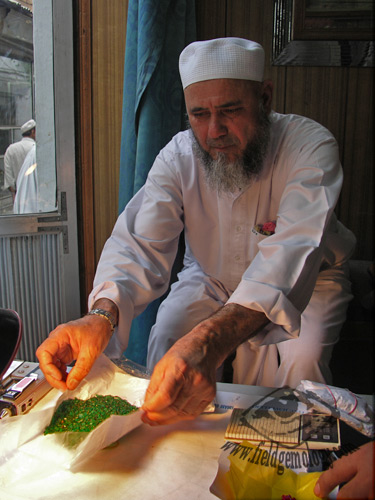 |
| The Namak Mandi market, in Peshawar (home of our correspondent), features a variety of gemstones. The dealer above proffers emeralds, which can come from a number of localities in Pakistan, as well as the autonomous region of Xinjiang in northwestern China. (Photo: Vincent Pardieu, Fieldgemology.org) |
The region has held its own strategic significance, of course, for gemstone and mineral enthusiasts, who might presume that the area’s miners and dealers also would be caught in the crossfire of current events. But as our correspondent from Peshawar explains in the following report, the global economic downturn has had, up until now, only a limited effect, while the future remains uncertain. (Note: The material referred to consists mainly of mineral specimens as well as facetable rough such as peridot and aquamarine.)
In anticipation of a visit to the Northern Areas…
The economic recession that started last year had little effect on actual miners and moderate effect on dealers and miners-cum-dealers from both countries. Miners in major mining areas (Northern Areas in Pakistan; Darra-i-Pech, Paprok, and Badakhshan in Afghanistan) remained busy in mining only. They could not comprehend the downturn for two reasons:
- They did a noble job in bringing out fresh minerals: their sole job and hence priority
- Those who flocked to these remote areas to buy their material were mostly people who lacked an astute and educated approach, and who were ignorant of the hard days in selling to come
Hence the reason miners got higher prices for their material because of the competition amongst the buyers in their mining areas. This resulted in no consequential effect on them by the economic situation the world over.
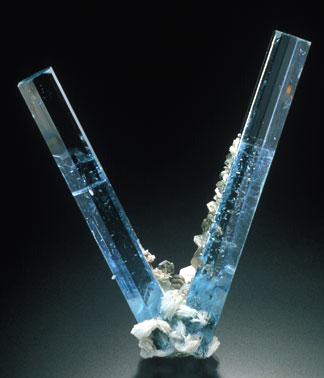 |
| Beryl: Northern Areas, Pakistan, 9.3 cm high. From our story, “Pakistan’s Gemstones: An Overview.”(Photo: Jeffrey Scovil; Gem: Bill Larson Collection) |
Those who bought, and brought their material to market, would not sell at reasonable prices because of the high price of their own purchases. These people waited and waited with the hope of having their minerals fetch profitable prices, but in the last four months, they have started adjusting to the call of the time. And so, in turn, word of the situation is now reaching miners of the major mining areas in both countries.
And the miners would do well to listen because their buyers actually (in most cases) pay them in installments and when installments stop or lessen, that’s a solid signal to miners to re-think their prices.
Also now miners suspect their buyers are not buying each and every item, but only best or finer ones, and thus their attitude has softened. The material that was brought to market last year is either lying unsold, or if has sold, must have been sold at higher prices.
Material that has reached the market this year has commanded good prices. And so now with each day passing, there is an increasing glimmer of hope that we’ll get better items at better prices. But this is only because the effect of this economic recession has just now started gradually to be felt by everybody in the minerals and gems business here.
Our correspondent promises us a report of his journey this week to the Northern Areas, with photos. We’ll be sharing them, of course, with Pala’s Gem News readers. [back to top]
Burma Bits
Year-End Stats Show Leaps and Bounds for Foreign Investment, Trade, Surpluses, Gem Production
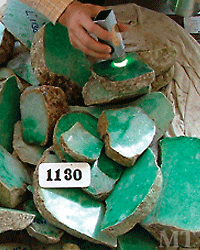 |
Secretary of State Hillary Rodham Clinton remarked back in February during her Asian tour, “Clearly, the path we have taken in imposing sanctions hasn’t influenced the Burmese junta. Reaching out and trying to engage them hasn’t worked, either.” As Tim Johnston of the Washington Post commented last week, Clinton’s remarks “have triggered an intense debate about what approach toward Burma … might prove more effective.” Sen. Jim Webb, who heads the Foreign Relations Committee, seems to be ready for a change, too.
Indeed, somehow the void created by sanctions in Burma appears to be being filled, as demonstrated by figures released since our last Gem News.
- Foreign trade for calendar 2008: Up 17.8% over 2007
- Trade surplus for fiscal year 2008–09: Up 4% over 2007–08
- Foreign investment for calendar 2008: Up 93% over 2007; Thailand, Britain, and Singapore lead the way
Gemstone Production Figures
Gemstone, jade, and pearl production for calendar 2008 (Central Statistical Organization):
- Total gemstone production: Down 15.5% from 2007
- Ruby production: Up 34% over 2007
- Sapphire production: Up 85.7% over 2007
- Spinel production: Down 47.4% from 2007
- Jade production: Up 54.5% over 2007
- Pearl production: Down 30.4% from 2007
March Emporium the Largest Sale Ever
And, as we noted March 24 on Palagems.com, Burma likely had its largest sale ever at the 46th Annual Myanma Gems Emporium, held March 8–20 in Yangon. Associated Press quoted an unnamed source as claiming jade sales alone topped $191 million.
We’ve updated our Burma Gem Sales and Statistics accordingly. [back to top]
Bite-Sized Bits
- Democratic Voice of Burma: Sanctions blamed for jade workers turning to sex work; see also Kachin News Group
- Irrawaddy: China pumped $850 million into Burma gemstone mining operations? No: that’s the figure for Chinese investment in Burma mining as a whole
- Mizzima: Burmese jade business eyes an upswing
- Mizzima: “Land of Jade” remains closed to tourists
- Mizzima: Green vs. green: Environmental cost of jade in Burma – article and photo essay
- Kachin News Group: Jade mining proceeds despite losses
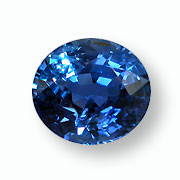 |
| This 2.79-carat natural blue sapphire from Burma is available. It has a medium intensity, allowing its brilliance to catch the eye. Inventory #7326. |
[back to top]
— End April Newsletter • Published 4/16/09 —
More Recent March 2009 News
March 24: Burma Jade Sale Earns $191 Million
Likely the largest sale ever—despite U.S. ban
 |
An Associated Press story today quotes an unnamed source as claiming jade sales of more than $191 million at the 46th Annual Myanma Gems Emporium, held March 8–20 in Yangon. Even though sales figures for pearls and gemstones were not available, this sale appears to be the largest ever, according to our Burma Gem Sales and Statistics.
The anonymous source—a participating merchant—also said that 3,500 lots of jade were sold. The article stated that 3,000 dealers attended, mainly from China and Hong Kong. [back to top]
March 2009 Newsletter
Pala International News
Gem and Gemology News
- SSEF’s Facette No. 16: A sneak preview
- Emerald Aisle
“El Itoco,” “Bahia,” “El Caballito Corriendo,” and a jet-setting jade Buddha? - The Australian Gemmologist Publishes Part One of Grahame Brown Memorial Issue
Industry News
- Burma Bits
- First the good news… Revival of Mae Sot Gem Trade
- BBC Report: “Burma’s gem mines face closure”
- Bite-Sized Bits
Books
Pala International News
Pala’s Featured Stone: Bi-Color Topaz
A new look at an exceptional gemstone
This month’s featured stone comes to us from Brazil and is precious and imperial in many ways.
When we’re talking about topaz, imperial is a descriptive term for golden orangey-yellow hues, and precious is usually reserved for the more pink-red hues. However, these terms can, and often are, used interchangeably by gem dealers. Exceptional colors like these are only found near the town of Ouro Preto within in the state of Minas Gerais in Brazil.
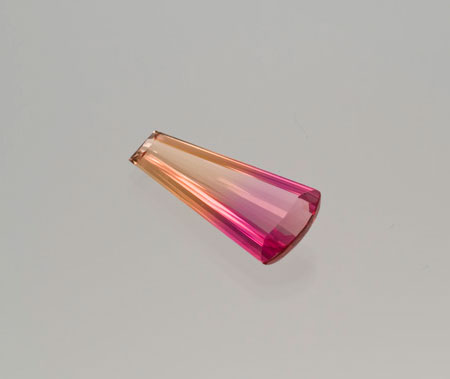 |
| Bi-color topaz, 13.35 carats, 27 x 11.8 x 5.42 mm. Inventory #15507. (Photos: Jason Stephenson) |
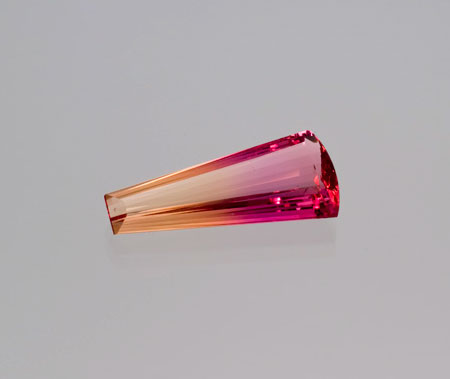 |
The top half of the stone exhibits the classic golden color, while the bottom seems to collect all the rich rosy pink color. This combination of color is extremely rare to find within the same stone—not to mention a flawless interior. And the origin of color in this jewel is natural; the original crystal actually exhibited these two distinct hues. (Oftentimes rich imperial colors can be heated to produce the pinkish hues.) A true collector’s gem fashioned to fit nicely into a one-of-a-kind pendant.
Interested? Select Inventory #15507, call, or email us to inquire. [back to top]
Larson Opals Grace AMNH Case
Recent Gifts Create Exquisite Display
On February 26, a single display case containing opals debuted at the entrance of the American Museum of Natural History’s Harry Frank Guggenheim Hall of Minerals. The twenty-five opals included—featuring several gifted by Bill and Jeanne Larson—are from diverse localities of Australia, Brazil, Honduras, Ethiopia, and the United States. (According to the AMNH, all but 15% of the world’s gem opals are produced in Queensland and New South Wales.)
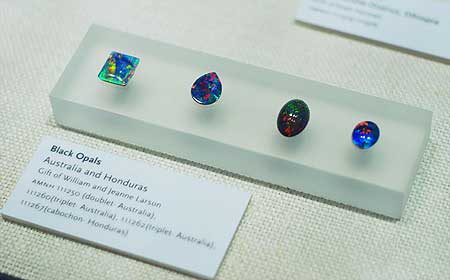 |
| Black opals gifted by Bill and Jeanne Larson: (l–r) Doublet and two triplets from Australia, and cabochon from Honduras. (Photo: Thomas Rosinski/National Jeweler) |
Fossilized opals also are on display in the exhibit. For an explanation of such fossil formation, see:
- March 10 article in National Jeweler
For more photos, see:
- A photo gallery of opals at American Museum of Natural History
- National Jeweler’s 10x blog
[back to top]
Gem and Gemology News
SSEF’s Facette No. 16
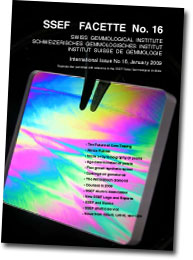 |
Swiss Gemological Institute Issues
Annual Newsletter
We’re pleased to give you a sneak preview of SSEF’s annual newsletter, Facette No. 16, before it’s posted on the lab’s own website. Some of the highlights:
- Wittelsbach Diamond: A report on SSEF’s pre-sale examination of this 35.56-carat blue diamond; “the best ‘tatami strain’ pattern that we have ever seen”
- Flame structure of pearls: The non-nacreous type…
- How much glass in ruby?: Micro X-ray tomography is a new alternative to determine volume
- The Future of Gem Testing: “Branding” of labs will help boost consumer confidence
 |
| Micro X-ray tomography can enable a non-destructive computation of the volumes of corundum and lead glass, allowing the original weight of the stone to be obtained without removal of the filler. (Photo: Dr. B. Putlitz, University of Lausanne, courtesy SSEF) |
[back to top]
Emerald Aisle: “El Itoco,” “Bahia,”
“El Caballito Corriendo,” and more…
Something to sip leftover cerveza verde by…
GIA Museum Unveils 472-ct. “El Itoco” Emerald Crystal
The Gemological Institute of America (GIA) announced yesterday the debut in its museum of a recently discovered 472-carat emerald crystal from Colombia’s Muzo region of the northeaster Department of Boyacá. This locality has produced some of the most spectacular emeralds ever seen.
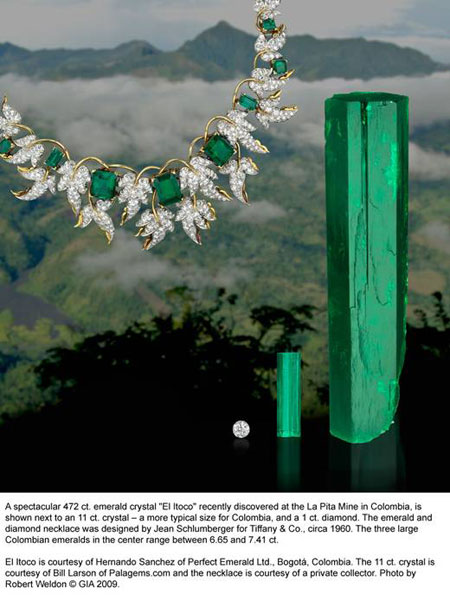 |
The crystal is dubbed “El Itoco,” from the local Muzo native people. The specimen is loaned to the museum by Ron Ringsrud (who we featured in last month’s Gem News) on behalf of mine shareholder and emerald exporter Hernando Sanchez. “This is the first time any of the Colombian mine owners have displayed such a significant emerald at any museum worldwide,” Ringsrud said, according to the GIA press release. The photo (above) included with the release features an 11-carat crystal supplied by Pala’s Bill Larson.
The emerald crystal is on exhibit until early Fall 2009. And while you’re there, be sure to see “Facets of GIA,” which includes blue and yellow Sri Lankan sapphire crystals from the collection of Bill Larson. [back to top]
Bad Luck “Bahia”?
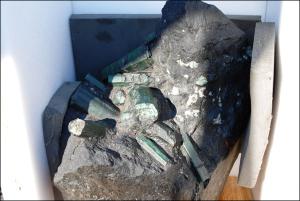 |
| Arm-sized crystals. Ownership of the Bahia Emerald was disputed by at least five parties. (Photo: L.A. County Sheriff) |
Last month we reported on the recovery of a missing 840-lb. rough gemstone, the “Bahia” Emerald, featuring ”arm-sized crystals.” On March 4 we posted an update on Palagems.com in an attempt to sort out the history of the stone’s whereabouts.
Later that same day, Associated Press claimed that Larry Biegler—who reported the emerald stolen last September, leading to a slew of claims on the rock—was “bowing out” of the legal case. Biegler’s attorney said the emerald “may be a curse for his client,” according to the widely carried story. Biegler himself was quoted as saying, “I have been threatened,” without elaborating. The lawyer for Todd Armstrong, another claimant, said claims on the rock might never end. “This could be the curse for my client.”
The case is continued, following conferences April 7 and May 4. [back to top]
Horsetail in Demantoid
At Tucson this year, J. Thomas Shofner of Palmetto Gems & Gemological Services stopped by the Pala booth and chatted with Pala’s Jason Stephenson. It seems that Shofner purchased a demantoid garnet from Pala at the 2003 show and took several photomicrographs to illustrate the distinctive “horsetail” inclusion seen in such stones.
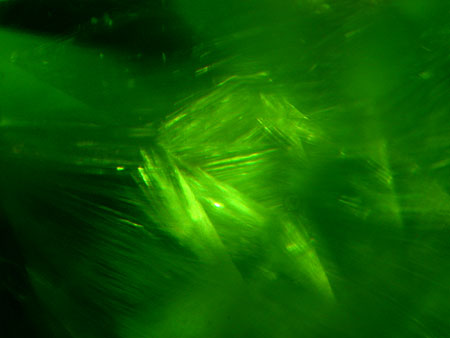 |
| El Caballito Corriendo… If you let your imagination wander you’ll see him charging out of the verdant ground of this demantoid garnet. (Photo: J. Thomas Shofner, Palmetto Gems) |
“[I]n the course of several shots, this one emerged,” Shofner told us. “I did not even see the ‘horse’ while composing the shot, only afterwards while viewing the results. Pure luck!” Yes, and this belongs in our inclusions gallery, The Internal World of Gemstones.
Do you have a curious, mm…, tale to tell about a fine gemstone? Feel free to let us know. [back to top]
Jet-Setting Jade Buddha Perhaps the World’s Largest
Billed as the world’s largest (or one of the largest, according to its sponsors) to be carved from gemstone-quality material, the “Jade Buddha for Universal Peace” began a worldwide tour—on Friday the 13th—in Da Nang, Vietnam.
A copiously illustrated brochure explains that the image was carved, by Jonathan Partridge and crew, from an 18-ton boulder named “Polar Pride,” honoring its Canadian arctic provenance. The brochure quotes Fred Ward, from his book Jade: ”Without doubt, this is the largest piece of gem grade jade found in my lifetime and perhaps the millennium [it was discovered in 2000].” A Handmark Gallery newsletter states that Partridge, born in the UK, studied over 15 years with Tibetan and Bhutanese masters in India before relocating to Tasmania in 2004.
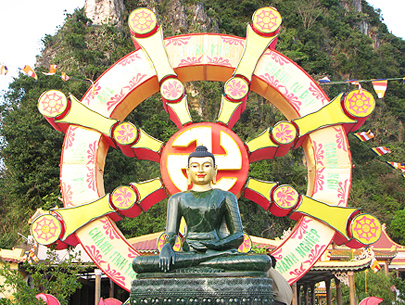 |
The image is modeled after that in the Mahabodhi Temple in Bodh Gaya, India, and thus assumes a “adamantine” posture (legs crossed, soles of feet facing up; from the Greek adamas, “invincible,” later “diamond”). The hand gesture is the Bhumisparsa mudra—touching the earth—a reminder of the moment when the prince Siddhartha attained his enlightenment: calling upon the earth to witness his resolve not to be distracted from his dharma, or path.
The final destination of the image is the Great Stupa of Universal Compassion in Bendigo, Australia (itself slated to be the largest stupa outside of Asia). [back to top]
The Australian Gemmologist Publishes Part One
of Grahame Brown Memorial Issue
Contains Study of Sapphire–Ruby Characteristics
of West Pailin, Cambodia
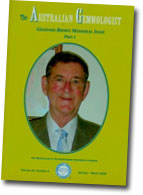 |
On the first anniversary of his death, Grahame Brown’s beloved The Australian Gemmologist has published reminiscences and selected papers by Australian authors. The issue also includes a list of the late editor’s own published works, which according to his obituary in JCKonline, topped 500.
The tribute issue includes a study titled “Sapphire–Ruby Characteristics West Pailin, Cambodia: Clues to Their Origin Based on Trace Element and O Isotope Analysis.” These analyses “confirm a clear distinction between magmatic origin sapphires … and metamorphic-origin sapphires and rubies,” according to the abstract. Comparison with comparable Australian material also demonstrated similarities and differences.
This issue of the journal also includes articles on:
- The similarities of Andamooka and Coober Pedy opal (often compared as being as similar as ”chalk and cheese”)
- Blue fluorescence in diamonds – As the abstract states, the article reviews “the complex and often contradictory history” of this subject
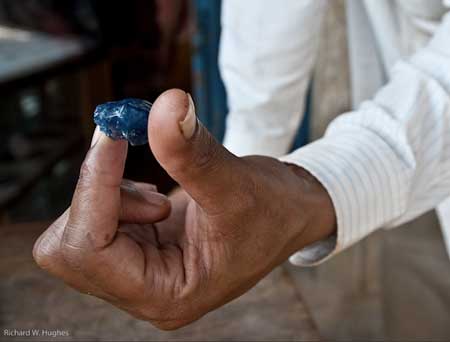 |
| Blue for you. Rough sapphire from Pailin, Cambodia, February 2009. Photo: Richard W. Hughes. See more photos from this Pailin trip at Ruby-Sapphire.com. |
[back to top]
Industry News
Burma Bits
First the good news… Revival of Mae Sot Gem Trade
Last month we looked at the tanking colored gemstone market in Thailand, and efforts to revive it. This month, the Bangkok Post reports (as posted on BurmaNet) that the market in Mae Sot is “teeming with Thais and foreigners shopping for gemstones.” An annual gems fair was held this year, February 27 through March 1—a collaboration of local government, commercial, and industrial concerns. Traders in Mae Sot’s Rim Moei market, near a cross-border bridge, noted that efforts like the gems fair are needed for a local trade that has been woefully quiet.
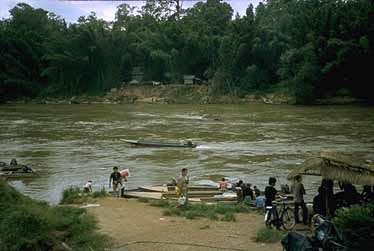 |
| Mae Sot’s importance as a trading center has a history. Richard W. Hughes has photographed the Moei River near Mae Sot, beyond which—behind the bamboo on the other side—was a thriving market run by Karen rebels in the mid-1990s. From Hughes’s “Where the Twain Do Meet: Thailand’s Border Towns.” (Photo: R.W. Hughes) |
Mae Sot, on Thailand’s western border with Burma, has had an influx of traders who, according to the article, have been abandoning Chanthaburi due to the closing of factories there, as we mentioned last month. Trade in border and other gemstone centers such as Mae Sot has been closely linked to legal and not-so-legal trade with Burma.
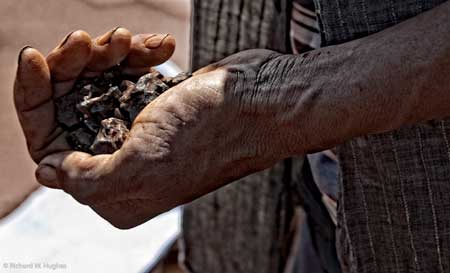 |
| A fistful of dollars. A sapphire miner at Chanthaburi’s Khao Ploi Waen holds a day’s production. The mine closed just days after Richard W. Hughes took this photo earlier this year. See more photos from this Chanthaburi trip at Ruby-Sapphire.com. |
The Tak Province Chamber of Commerce has proposed building a second “friendship bridge” across the Burma border, according to The Irrawaddy on Monday. According to the story, Trade between Mae Sot and Burma’s Myawaddy earns Thailand a handy $28 million per month, per the Chamber. [back to top]
BBC Report: “Burma’s gem mines face closure”
BBC reported yesterday that orders for stones from Burma have “almost come to a halt” and prices for them have “plummeted.” The story quoted a gem trader as saying that the price for a viss (~1.63 kg.) of jade rough had commanded just over £100; now it’s about £10.
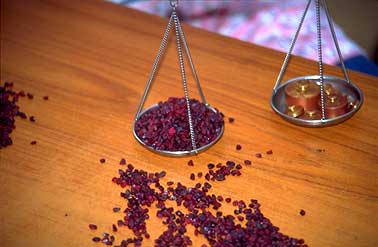 |
| Unlucky 13. When Richard W. Hughes took this photo of untreated Mong Hsu ruby at Thailand’s Mae Sai market in April 1996, he could write that the region “completely dominated the world's ruby trade in sizes of less than 3 ct.” Thirteen years later, the BBC says that a 3/4 of the workers in that mining area have lost their jobs and left. (Photo: R.W. Hughes) |
Predictably, the U.S. ban on Burma ruby is cited for the collapse of the market. Others, the BBC report continued, have questioned this assumption, pointing to the fact that “most Burmese gems end up in Europe,” so the sanctions cannot solely be blamed.
The article claimed that the state-owned Myanmar Economic Corporation had “stopped its operations altogether” due to drop in orders from Thailand. Statistics were cited:
- 500,000 people worked in all of Burma’s mines—10% of the working population
- 75,000 out of 100,000 in the famous Mong Hsu region are now out of work and have left the area
[back to top]
Bite-Sized Bits
- Mizzima News: 46th Gems Emporium underway in Yangon, March 8–20, in spite of two bomb explosions March 3 (Kachin News Group)
- Kachin News Group: Jade traders turn to dope and gold for better deal
- The Myanmar Times: Myitkyina (Kachin)-to-Yunnan (China) road could help boost numbers
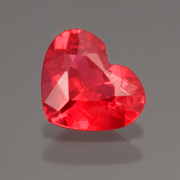 |
| Red spinel from Burma. This 1.34-carat heart-shaped stone is highly fluorescent. Search on Inventory #11963. (Photo: Mia Dixon) |
[back to top]
Books
Cameos Old & New
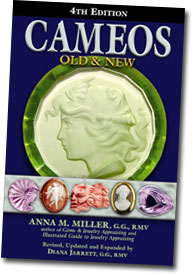 |
Fourth edition of the perfect
introduction to the subject
The 4th edition of Cameos Old & New, by Anna M. Miller, has been revised, updated, and expanded by Diana Jarrett. It’s a current encyclopedia on cameos including: history, mythology, production, materials, appraisals, collecting, artistry, and the future of cameos.
The Australian Gemmologist called Cameos Old & New "the best introductory book on cameos.”
This is a must-have for anyone involved along the path cameos take, from start to finish, into the market place, and beyond. The book contains 371 pages of insightful information, detailed pictures, and 16 color plates. The book is then concluded with a chronology of engraved stones and cameos in Europe, along with a glossary of glyptic-art and jewelry terms.
The book is widely available, including from the publisher, Gemstone Press.
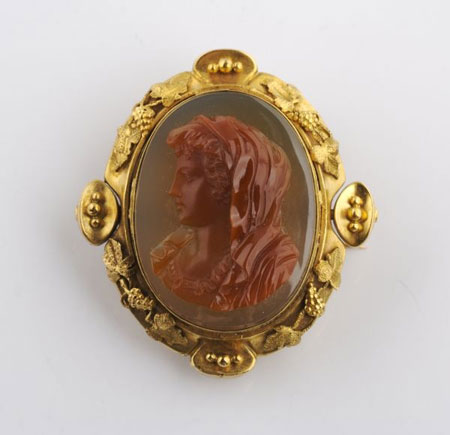 |
| Old & New. Above: Leslie Hindman Auctioneers sold this Victorian yellow gold, carnelian, and white agate cameo, circa 1860, for $2640 in February 2007. (Photo courtesy of Leslie Hindman Auctioneers) Below: “Esperanza” created in the Munsteiner cut, from citrine, by master carver Erwin Pauley. (Photo courtesy of Erwin Pauley) |
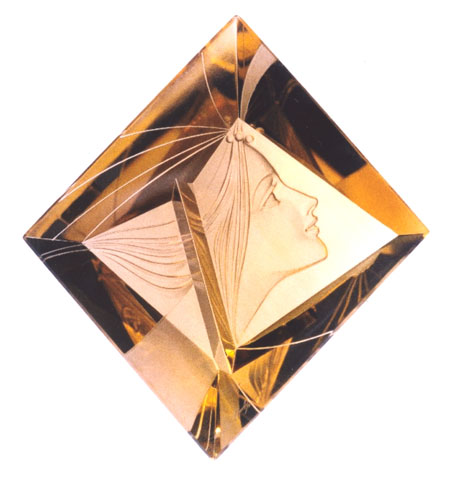 |
[back to top]
Gill’s Historical Index Gets Update
Check back often for free revisions
Joseph O. Gill’s Historical Index to Gems and Jewelry Online, which we profiled last month, has been updated as of March 8. The book, in Microsoft Word 2007 format, is available for free download from the Internet Archive.
Gill urges those interested in the index to check the above website from time to time in order to take advantage of the most recent version. [back to top]
— End March Newsletter • Published 3/18/09 —
Other March 2009 News
March 4: 840-lb. Emerald Follow-up
The Wall Street Journal reported on Saturday that five people now claim ownership of the “Bahia” Emerald, an 840-lb. specimen containing “protruding arm-sized green crystal cylinders,” according to the story. The article, and another from yesterday’s Los Angeles Times, trace the rock’s history, as alleged by the various players:
- 2001: Dug from a mine in Bahia, Brazil; owned by mine-rights owner and a business partner
- 2001: Gem trader Anthony Thomas purchased it for $60K from Brazilians; he claims he was told at the time that the emerald was stolen during transport
- 2005: Brazilians shipped it to Ken Conetto, a business associate (and amateur geologist) in San Jose, CA; Conetto attempted to find a buyer
- Summer 2005: Conetto shipped it to New Orleans for prospective buyer, but warehouse hit by Katrina and specimen is submerged for weeks; sale nixed; returned to San Jose
- June 2008: Conetto asked Paradise, CA, gem broker and real estate investor Larry Biegler to help sell the emerald; they drove it to Los Angeles to drum up interest, then had a falling out
- Biegler put up the emerald as collateral for a $1 million diamond deal with Todd Armstrong and Kit Morrison, Idaho businessmen; they claim the deal went bad and transported the rock to Las Vegas for warehousing
- September 2008: Biegler reported the emerald stolen from a vault in South El Monte
- December 2008: Armstrong and Morrison released stone to L.A. Count Sheriffs until ownership can be sorted out
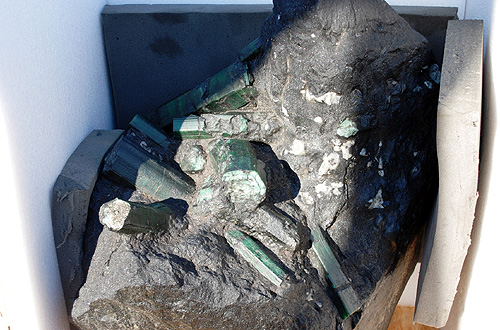 |
| Arm-sized crystals. Ownership of the Bahia Emerald is disputed by at least five parties. (Photo: L.A. County Sheriff) |
The L.A. Times quoted attorneys from a court hearing yesterday as suggesting that the number of those claiming ownership of the emerald may continue grow. [back to top]
February 2009 Newsletter
Shows and Conferences
Pala International News
Gem and Gemology News
- Standley Collections Now Online
- Emerald Aisle
“Bahia” Emerald, Gota de Aceite, y más… - Vince’s Winza
- Pink Tubes in Cuprian Tourmaline
Industry News
- Hard Times, Hard Assets
When the going gets tough, the affluent go shopping… - Thai Colored Gemstone Market Founders
- Burma Bits
- Largest Gems Museum Opens
- Phakant Opens to Tourists
- Sluggish China Sales, U.S. Sanctions Hurt Mines, Traders
- Johachidolite from Mogok
- Bite-Sized Bits
Books
Shows and Conferences
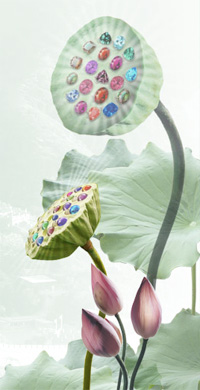 |
13th ICA Congress
May 5–10, 2009
Six-day conference held in jewelry manufacturing center, Guangzhou
Congress 2009 of the International Colored Gemstone Association will be held just 75 miles northwest of Hong Kong, in the port city of Guangzhou (Canton), at the mouth of the Pearl River.
According to the Congress website:
Industry leaders from around the world will exchange trade updates and views through presentations and discussion sessions designed to encourage lively debate and networking. The ICA Congress is expected to draw the largest number of attendees to date. Exciting excursions and activities complete the full schedule of networking events.
Speakers at the conference will include trade experts to discuss both China-specific and global gem business details. Industry leaders and ICA members also will contribute to the dialogue. [back to top]
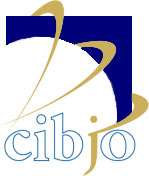 |
CIBJO Congress
May 3–5, 2009
Conference to be held at
historic Çiragan Palace Kempinski
On your way to the ICA Congress, stop in Istanbul for CIBJO, the World Jewellery Confederation, Congress 2009.
Just as the ICA Congress plans to focus on China, the CIBJO Congress will look at Turkey and its significance in EurAsian markets, according to a February 13 press release. CIBJO president Dr. Gaetano Cavalieri:
The fact that Turkey is hosting the event is very significant. Like no other market, the country represents a blend of East and West, and it has helped unlock the fast developing markets in the republics of the former Soviet Union, as well as in the Middle East. Turkey also represents a strong jewellery market in its own right, and it is an economical jewellery design and manufacturing centre within just a few hours flying time from Western Europe. It is exactly the type of the centre that we need to look to in difficult times such as these,"
The Congress 2009 website is a little thin on details at present. Meanwhile, check out:
- Congress 2008 website
- CIBJO’s sustainable jewelry website.
- Çiragan Palace Kempinski, site of Congress 2009 [back to top]
Pala International News
Pala’s Featured Stones: From the Rough
An assortment of newly acquired gems that were bought
in the rough at this year’s Tucson show
One fun and curious aspect of the Tucson show is the chance to roll the dice and buy rough crystals of various colored stones in hopes that they will morph into beautiful gems. Evaluating the rough and trying to imagine what the finished stone will look like can be enjoyable. There’s always a gamble when buying rough gem material, but the payout can be surprising and rewarding.
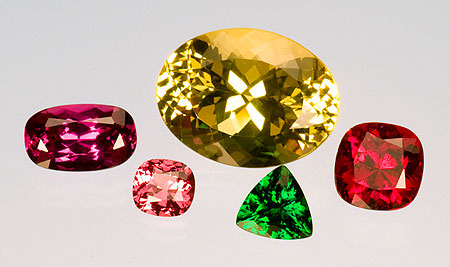 |
| Smooth around the edges. All five of this month’s featured gemstones came from unfaceted material obtained by Pala International at this month’s Tucson show. (Photo: Jason Stephenson) |
This month we feature a few jewels that came from the rough and into the light as happy, newborn jewels. A 36.67-carat large oval greenish-yellow apatite from Mexico, a 7.57-carat elongated cushion umbalite garnet from Tanzania, a 1.91-carat small cushion pinkish red spinel from Tanzania, a 2.80-carat trilliant chrome tourmaline from Tanzania, and a 6.42-carat cushion rubellite tourmaline from Nigeria.
Introducing Mia Dixon
Perhaps you’ve noticed that photo credits for many of our gemstones (such as the lovely sapphire pictured above) now refer to “Mia Dixon.” Mia took charge of the shutter upon the departure of in-house photographer Wimon Manorotkul in late September. (We were told by Wimon that Mia was a quick learner, as tips of the craft were passed on while they worked together.)
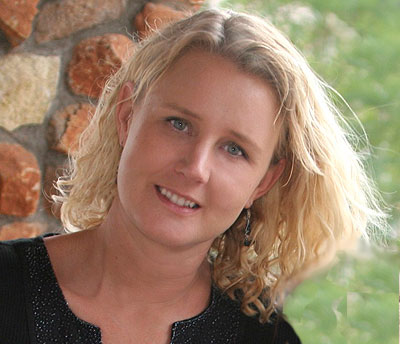 |
Mia Dixon first started at Pala International back in 2002 as the Administrative Assistant. She left the company in July of 2004 to raise her first child.
In July of 2008 she joined the team again as the resident photographer, mostly of gemstones but also some shots of mineral specimens. Mia is working part-time so she still can enjoy spending time with her beautiful boys Erik and Axel.
Mia Dixon was born and raised in the area of Gothenburg (aka Göteborg), the trade, educational, and cultural center of southwestern Sweden. She first arrived in California in 1994. Mia received her Associate’s Degree in Fashion Merchandising & Design in 1996 from Palomar College in nearby San Marcos, California. [back to top]
Gem and Gemology News
Standley Collections Now Online
Master Carver Offers Unique Creations
Longtime readers of Pala International’s Gem News will be familiar with the work of Bud Standley. Standley’s carved chrysocollas were our featured items for April 2006. Beginning his career with turquoise, Standley was one of the first artists to move on to azurite and chrysocolla.
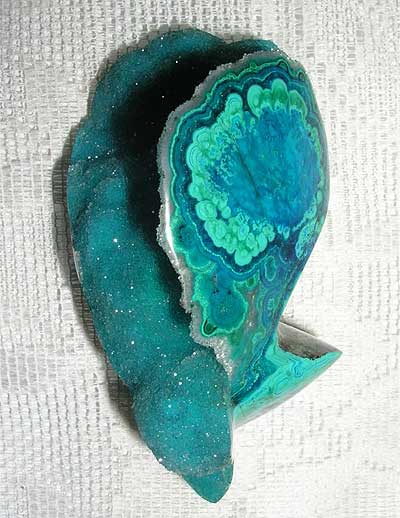 |
| Butterfly-wing effect? This carved chrysocolla, with its lovely drusy surface preserved, comes from Arizona’s Baghdad Mine. (Photo courtesy Bud Standley) |
Now Standley has launched his own website, StandleyCollections.com. Visitors can browse the diverse work in gemstones, jewelry, sculptures, and more. He is available for personal commissions as well. [back to top]
Emerald Aisle: “Bahia” Emerald, Gota de Aceite, y más…
At the end of December we ran across the story of the recovered 850-pound, $370-million emerald. But first let’s look at something a little more interesting…
Oil, roil, and butterfly wings
Prominent emerald dealer and fair-trade advocate Ronald Ringsrud has been trying to clear the muddy waters surrounding the phenomenon of gota de aceite—literally “drop of oil”—the subtle roiling or “butterfly wing” effect unique to rare Colombian emeralds. His most recent prominent discussion of the phenomenon is found in the Fall 2008 Gems & Gemology (much G&G content is now archived online).
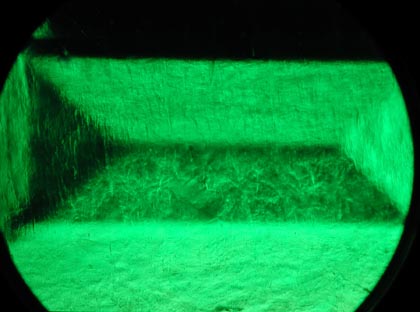 |
| Troubled water. The exquisite subtlety of the roiling effect known as gota de aceite is beautifully rendered in this photomicrograph (above) from the gemstone below. (Photo courtesy Ronald Ringsrud) |
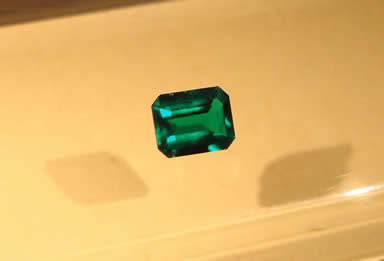 |
“Only among connoisseurs is this effect known; it is misunderstood more than understood,” Ringsrud writes earlier, in Rivista Gemmologica Italiana. While the cognoscenti (couldn’t resist…) appreciate gota de aceite in emerald as a special quality (compare with the velvety Kashmir sapphire), Ringsrud protests its hasty application in Europe and the U.S. “to any fine emerald; even if the emerald does not have this effect.” He estimates its occurrence to be limited to only one in a thousand to two thousand Colombian emeralds.
¿Ala de mariposa?
Due to negative associations of the word oil in gemological circles, Ringsrud explains that the phenomenon now is referred to as the “butterfly-wing” effect or the prosaic “calcite precipitation.” (Indeed, Ringsrud’s proclivities tend more to the poetic: “It is absolutely necessary to include POETRY, ROMANCE & ADVENTURE in presenting the complete picture of these exotic colored stones.”)
Ringsrud explains exactly how the effect is achieved by Nature on the home page of his Emeraldmine.com. An in-depth discussion of the phenomenon will be included in a chapter of his forthcoming book. See Gemlab for a fully illustrated laboratory report on the phenomenon by Thomas Hainschwang. [back to top]
Mudslide Kills 2, Creates New Lake in Emerald Mining District
A mudslide near the entrance to the La Pita emerald mine, in the northern Colombian department of Boyacá, killed a mining employee and a construction worker, according to Ron Ringsrud. The Minero River became a lake for over two hours in early January, raising the water level, and threatening the emerald mine entrance. See Ringsrud’s website for “before and after” photos of the site.
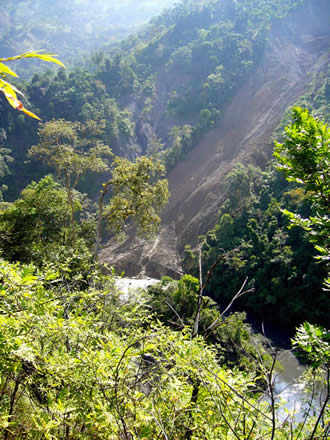 |
| Mudslide. The entire side of this mountain near La Pita mine slide into the Minero River, creating a temporary lake. (Photo courtesy Ronald Ringsrud) |
[back to top]
840-lb. “Bahia” Emerald Recovered
 |
| Mugshot. The Bahia Emerald was missing for months before being located in Las Vegas. (Photo: L.A. County Sheriff) |
In late December, the Los Angeles Sheriff’s Department announced it had recovered the “Bahia” Emerald, an 840-pound specimen that is the center of confusion and litigation. According to a December 26, 2008 Los Angeles Times story, the specimen was stolen in September from a vault in South El Monte, finally being located in Las Vegas.
Ownership of the stone is disputed—as is its worth, which has been pegged at $370 million. We put the price question past Ron Ringsrud, who was skeptical. When pointed to a blog discussing the specimen’s provenance, Ringsrud immediately focused on the comment by dealer Butch Vallee. Ringsrud said a visit to Vallee was informative: “I was at his store, looking at the big emerald pieces and learned a lot: Brazil can produce BIG but not FiNE. Everything has a price—but millions, no.”
The sentiment was echoed by International Colored Gemstone Association VP Edward Boehm, who suggested that price might be tied to hype. [back to top]
Émeraudes très, très Jolies
If you watched the Academy Awards like we did, on a large screen, you couldn’t help but do a double-take at the robin’s-egg-sized emerald cocktail ring worn by nominee Angelina Jolie. And those earrings. All in all, 180 carats of dazzling Colombian emerald, designed by Lorraine Schwartz. It’s enough to make an octomom green with envy. [back to top]
More “green” news from the Emerald Aisle
- Revere Academy: This Bay Area jewelers school offers instruction on how to “green” your studio; see also this JCKonline profile
- The Loupe: GIA’s online-only Fall 2008 issue contains rich content from more than a dozen guest columnists on “where GIA, and indeed, the industry as a whole, stands on the green scale” (pp. 13–33)
- InColor: ICA’s quarterly journal contains Vincent Pardieu and Richard W. Hughes’s “Tsavorite – The Untamed Beauty” (pp. 12–20); the article also is archived at Ruby-Sapphire.com
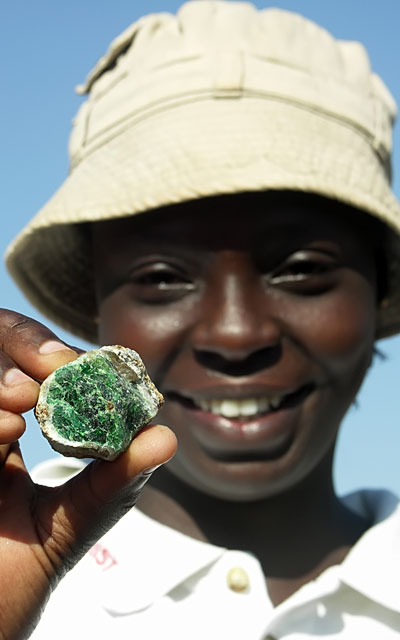 |
| It’s a blast… Wangui Gladwell, the daughter of the Baraka mine owner in Kenya, proudly displays a tsavorite porphyroblast. From the article “Tsavorite – The Untamed Beauty”; see links above. (Photo: V. Pardieu/Gübelin Gem Lab, 2007) |
[back to top]
Vince’s Winza
Pardieu takes us on the rutted road to a new rubyland
In September, we pointed to much information regarding rubies from Winza, Tanzania. In December, we featured rubies from Winza as that month’s special gemstone offer.
 |
| Water works. Plentiful water from the Mtindiri River is crucial to the washing of the gem-rich ground. As a hedge against the dry season, the miners build ponds and dams to collect water. (Photo courtesy Vincent Pardieu, Fieldgemology.org) |
This month we’re pleased to point to Vincent Pardieu’s extensive account of the expeditions he led last spring to Winza, in central Tanzania. Copiously illustrated, as usual (with video and inclusions as well), the visits, in part, led to the publication of a 25-page article, published in the Winter 2008 edition of Gems & Gemology. “Rubies and Sapphires from Winza, Central Tanzania” was co-authored by an international group of ten gemologists and scientists. The article includes discussion of the distinctive inclusions and color zones unique to the material from Winza.
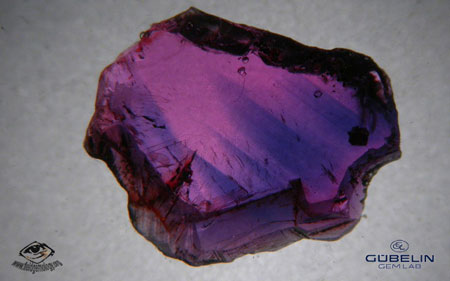 |
| Rubylicious. Color zoning distinctive to Winza material is shown here. (Photos: Above, courtesy Vincent Pardieu, Fieldgemology.org, and Gübelin Gem Lab. Below, Mia Dixon) |
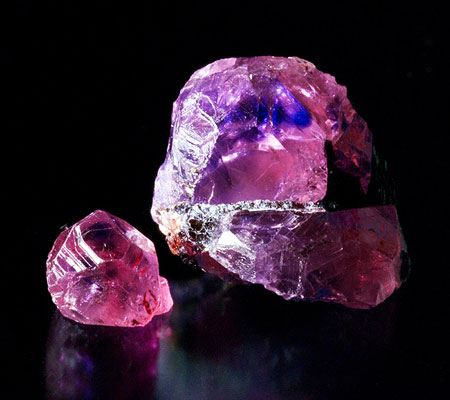 |
[back to top]
GRS Issues Book, DVD on Winza Ruby
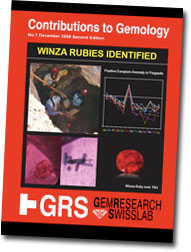 |
Just before Tucson, Dr. Adolf Peretti, Director of GemResearch Swisslab (GRS), notified us about the lab’s publication of a 100-page hardcover book on Winza ruby.
Winza Rubies Identified is No. 7 in GRS’s Contributions to Gemology series. A PDF of the book’s table of contents is posted on the GRS website.
Also available is a two-part DVD:
- Part A: Expedition to the New Ruby Mines in Winza, Tanzania
- Part B: Sappire Mining in Madagascar
[back to top]
Pink Tubes in Cuprian Tourmaline
Indication of Locality and Lack of Heat-Treatment
According to a lab alert issued January 28 by the Gemological Institute of America (GIA), “Samples of blue to blue-green, copper-bearing tourmaline containing surface-reaching growth tubes surrounded by intense pink ‘sleeves’ have recently been seen in the trade.”
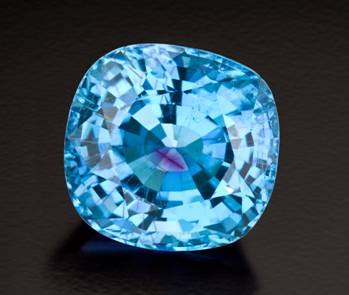 |
| This 27.63-carat copper-bearing tourmaline (examined for the GIA report) contained a large, obvious pink growth tube. (Photo: Robert Weldon, © GIA) |
GIA Laboratory staff members determined that the phenomenon is produced by fluid containing naturally occurring radioactive material. The presence of such pink zones, according to the report, is evidence that the material has not been heat-treated, and also is an indication of locality: Mozambique.
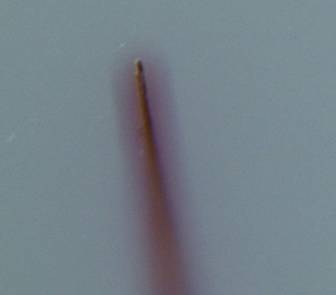 |
| Above: When these tubes are viewed near-parallel to their length, a pink zone can be observed immediately surrounding the tube. The growth tube is 0.06 mm in diameter. Below: As shown here, cracks extending from and between the tubes are also often lined with a pink zone as well. Approximate horizontal field of view is 2.15 mm. (Photomicrographs: John I. Koivula, © GIA) |
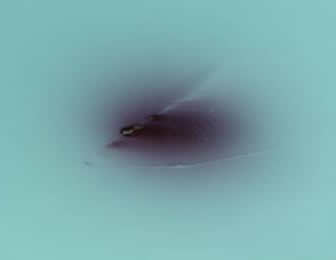 |
Read the entire report, in anticipation of a Spring 2009 article to be published in Gems & Gemology in April. [back to top]
Industry News
Hard Times, Hard Assets
When the going gets tough, the affluent go shopping
Things may be slow in the gem trade—AGTA reported that this month’s GemFair attendance was down by 19%—but wealthier clients are swapping soft-market assets for the hard stuff, according to a February 2 story from National Jeweler.
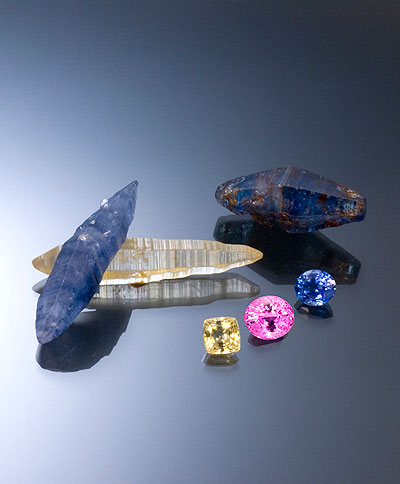 |
| Can’t decide? Take one of each. Natural Ceylon sapphire crystals and faceted gemstones. (Photo: Wimon Manorotkul) |
The article includes examples of jewelers who are seeing booming business transactions with eager investment buyers—and “hoarders”—during a dismal holiday shopping season when “Black Friday” gained new and unfortunate meaning. One Southern California dealer claims that, unlike during the 1987 stock market mm… correction, gems and jewelry are seen as an investment option worthy of consideration.
The story also highlights the in-the-pocket portability of jewels—compared with, say, real estate—for jet-setting, euro-dropping shoppers.
For more on the subject, see “Collecting & Investing in World Class Colored Gemstones” by Jason Stephenson, on Palagems.com. Or just get Warren Buffet to help you refinance. [back to top]
Thai Colored Gemstone Market Founders
Prices can’t go lower?
 |
| Das Kabinett des Doktor Chanthaburi. A selection of chemicals used in the treatment of gemstones, 2004. (Photo courtesy Vincent Pardieu, Fieldgemology.org) |
This is nothing new, but the Bangkok Post ran a story on February 18 discussing the sad state of the Thai colored gemstone market. Chirakitti Tang, president of the Thai Diamond Manufacturers Assoc., said prices for such stones as ruby and sapphire already are so low they aren’t apt to go lower.
He reaffirmed what we’ve been hearing: 80% of Chanthaburi factories have closed down over the past six years. He blamed the reputation that Thai stones have obtained over the last decade due to undisclosed enhancements. He suggested that the government partner with the private sector in order to develop a disclosure strategy that will satisfy the wary buyer.
Commerce Ministry Launches Two Campaigns
JCKonline reported February 24 that Thailand’s Commerce Ministry has launched two major campaigns to bolster gems and jewelry exports during the economic downturn. Campaign #1 urges the jewelry industry to abide by import and export regulations. A misunderstanding regarding customs procedures has caused rough gemstones to enter the country without declaration, when in fact no duties or VAT are routinely charge. Campaign #2 is a marketing scheme to bill the Silom, Mahaesak, and Surawong centers “on world maps,” according to the article. [back to top]
Burma Bits
Largest Gems Museum Opens
The Gems Museum (Nay Pyi Taw) of Myanma Gems Enterprise opened February 12 in the administrative capital, according to the official New Light of Myanmar daily.
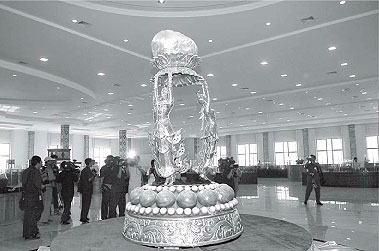 |
According to the story, the museum features
the 6.2 centimetres long and 3 centimetres high world’s largest natural pearl weighing 45.06 mommes (845 carats or 929.50 rati) decorated with three female celestial beings, the most valuable Myanma cultured pearl weighing 9.8 mommes (104.39 carats), the valuable Myanma jade stone weighing 69 kilos, the Myanmar orchestra and ornaments made of jade, the largest Myanma ruby weighing 21,450 carats, and other ornaments made of ruby, quartz, Myanmar gold and silver wares and jewellery and uncut Mogok gem stones, various uncut gem stones and granite stones.
The museum campus also includes 20-square-foot retail spaces for 60 businesses. The new museum now outranks the existing Yangon gemstone museum in size. [back to top]
Phakant Opens to Tourists
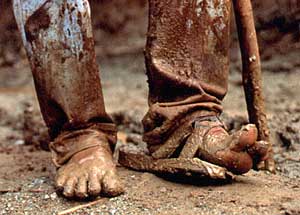 |
| This photo, taken by well-traveled gemologist and dealer Olivier Galibert is included in a 20th century account of a rainy season adventure in Burma’s Phakant area of Kachin State. |
For those bored by the conventionality of the World’s Largest Natural Pearl, slap on your gumboots because the roads leading to Phakant (aka Hpakan, Hpakant, Phakan) are open again for intrepid gemologists.
Tour companies reported that visas will be granted to the jade producing area that had been off-limits since last February, according to the foreign-language news outlet 7-Day News, by way of Xinhua News Agency.
According to the story, visas need to be obtained 14 days prior to travel in the region. [back to top]
Sluggish China Sales, U.S. Sanctions
Hurt Gemstone Mines, Traders
 |
| Something sumptuous for a sluggish season. The slightly windowed Burma ruby above is priced to take the edge off. So is its unenhanced cousin below. (Photos: Mia Dixon, top; Wimon Manorotkul, bottom) |
 |
A January 28 Mizzima News story discusses the slowdown in Burma’s mining sector trade with China. One miner interviewed said he had reduced production. Miners in commodity minerals have shifted to maintenance mode. Some small mine operations may be forced to sell.
China’s economy slowed to a 6.8% increase in the fourth quarter of 2008 and was only 9% for the year, the first single-digit increase since 2003, according to the official People’s Daily.
Mogok Insiders Point to Sanctions
On February 19, The Irrawaddy relayed a report by a Mogok gem trader that at least 50 mines in the area have slowed down production, with some closing down altogether in the wake of U.S. sanctions. Skittish from the soft market, investors are loath to shell out the money needed for fueling heavy equipment used in the mining.
Traders from other countries, including Thailand and China, are becoming more scarce, according to the story. A Burmese journalist speculated that the government gemstone auctions—the next one is scheduled March 8–20—could be suspended if Chinese fail to attend.
The issues of sanctions, their effectiveness, and collateral damage was the subject of International Colored Gemstone Association (ICA) meetings held in Dubai in October. See the online version of ICA’s Winter 08/09 InColor (pp. 10–11) for a report on the discussions.
Yangon Market, Prices Down by 50%
The same Irrawaddy story includes a claim by Yangon jewelers that buying in the city by international traders is down by 50%, just as prices have been halved as well.
Burma Production Figures May Hide the Hit
Because official Burma production statistics are released about 70 days after a given month’s end, we won’t know the figures for December and January for some time. The figures for the three months ending November 2008, released February 6, show a general downward trend in overall production, but look at the figures for sapphire and jade.
| Gems (in carats) | |||||
| Sep–Nov | Ruby | Sapphire | Spinel | Peridot | Total |
| 2007 | 377,498 | 48,209 | 377,081 | 245,999 | 7,021,860 |
| 2008 | 403,895 | 222,482 | 108,048 | 18,672 | 5,348,920 |
| Difference | +7% | +461% | –71.5% | -92.5% | -24% |
| Sep–Nov | Jade (in kg) | Pearls (in mommes) | |
| 2007 | 2,842,467 | 58,775.78 | |
| 2008 | 8,565,091 | 49,421.26 | |
| Difference | +301% | –18% |
We’ll report on calendar year 2008 figures next month. See our Burma Gem Sales and Statistics anytime for the latest. [back to top]
Johachidolite from Mogok
Johachidolite, once found only in Korea, has for the last ten years been trickling out from Mogok. Three studies from the last two years will be of interest to collectors who want to stretch the Mogok envelope a bit. As Dr. Peretti writes in his introduction to the GRS study:
As we constantly studied the ruby and sapphire mines in Mogok, it was only a matter of time to discover one of the rarest collector gems in the world: Johachidolite. It is a true gem with its vivid color, high brilliancy due to the high refractive index, high density and Mohs hardness of over 7.5.
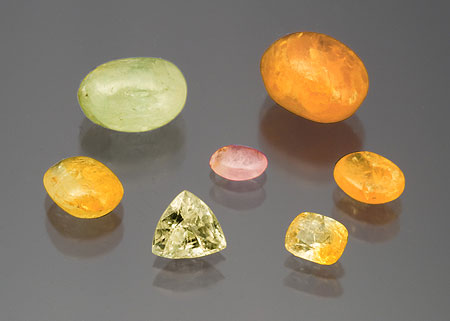 |
| The many hues of johachidolite from Mogok in Burma—available from Pala International. The J-word comes from the Japanese colonial-era name, now obsolete, for the Korean locality where the material first was found. (Photo: Mia Dixon) |
Here are the reports on johachidolite:
- Contributions to Gemology (GRS Nov. 2007): 53 pages of all facets (no pun intended…) of johachidolite, including composition and structure, rare-earth element “fingerprint test” for origin, geology, and visits to localities; also included are 60 pages of archival material from the GRS library
- European Journal of Mineralogy (Oct. 2008): This study, co-authored by GRS’s Dr. Peretti, refines the structure-related information on johachidolite
- Gems & Gemology (GIA, Fall 2008): Study of gem johachidolite from Burma, in a range of colors, shows trends for beryllium, uranium, thorium, and lead; also rare-earth element concentrations
[back to top]
Bite-Sized Bits
-
Myanmar Times: Myanmar Geosciences Society publishes first edition of English-language Journal of the Myanmar Geosciences Society (MGS)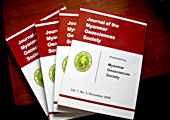
New journal published by MGS includes a paper titled “Modes of occurrence and origin of precious gemstone deposits of the Mogok Stone Tract.” - Yangon City: Burma exhibits gems and jewelry at IIJS Signature Goa, Feb. 20–23
- The Irrawaddy: Visiting dignitaries receive smuggled gemstones—sort of…
- Myanmar Times: Government to plant 1.9 million mangroves as natural barrier against future cyclones
- Larry Jagan: Formerly of the BBC, Jagan reports (in various news outlets) on the increase in poppy cultivation in northeastern Shan State, as the gemstone market dries up in places like Panghsang, due to little Chinese demand
- Rapaport News: George W. Bush, less than a week before leaving Washington, altered the Tom Lantos Block Burmese JADE act
[back to top]
Books
Gill’s Index Available as Free Digital Download
Updated, Searchable Index of 20,000 Docs on Gems and Jewels
Joseph O. Gill is offering a newly revised edition of his classic Gill’s Index to Journals, Articles and Books Relating to Gems and Jewelry. For free. And in an easily searchable digital format. Originally published in 1979, Gill’s “analog” database was only the second book published by the Gemological Institute of America that was not written by a GIA staff member, according to a lively scrapbook/biography offered as “Appendix 1” to the new digital version.
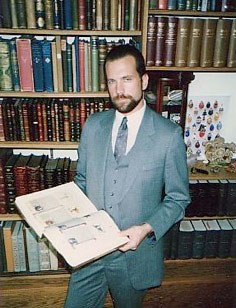 |
| Joseph O. Gill, the author, in his library at Gill and Shortell, Ltd., San Francisco, 1987. (Photo courtesy Joseph O. Gill) |
Both Gill’s Index and Appendix are available for free download via Internet Archive (host of the famous Project Gutenberg).
Since 1988, Joseph O. Gill, formerly of Sotheby’s and his own business Gill and Shortell Ltd., has spent his (early) retirement on the big island of Hawaii and, since 2003, trotting the global south and east that he’d traveled as a child—this go-’round sampling far-flung sights and vegan delights, laminated cheat-sheet in hand. (How do you say, “No flesh, please,” in Laotian?)
Gill packed a lifetime of achievement into his brief fifteen-year career: successfully challenging the Gemmological Association of Great Britain’s first-year exam and receiving both his F.G.A. from Gem-A and G.G. from GIA in 1973; a year later becoming head gemologist for Boston’s J. & S.S. DeYoung Inc. (and providing the firm with its single biggest sale—sans commission); being appointed western U.S. director of Sotheby’s jewelry sales in 1980 (increasing business by 400% in the first year); eighteen months later starting his own business and then being offered (and declining) the top job at GIA, by Richard Liddicoat…
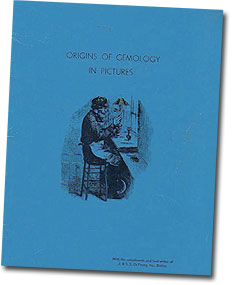 |
| Origins of Gemology in Pictures was compiled by Gill for the AGS Conclave held in Boston, during his time as J. & S.S. DeYoung’s head gemologist. (Image courtesy Joseph O. Gill) |
And, of course, the publication of his magnum opus, the product of nine years of compilation on 48 inches’ worth of 5"x8" index cards—about 4,500 by our estimation. Typing the book’s draft alone took eighteen months.
So you can look up France and find that a rough diamond was found there or what gems were found in Antarctica or California or Nigeria or Ghana or Florida or in the oceans or anywhere including from outer space. You can find all the references ever in English from the first book done by Thomas Nicols on gems in 1652 until 2008, near 350 years of all the publication in English on gems along with more than 18 journals on gems and minerals. I went through each sentence of each publication and all was put in this handwritten annotated index.
While still on the road in Katmandu, Gill obtained a high-quality optical character recognition scan of the original Index. He proofed the text and for three years, with limited resources, he revised the text to the best of his ability. The text includes links to other gemological works offered by Internet Archive, where Gill also has posted:
- The Personal Scrapbook of Henry D. Morse (Trained the First Diamond Cutters in America) and Charles M. Field (Inventor of the Modern Diamond Cutting Machine) – Scrapbook (and Many Extras)
- Origins of Gemology in Pictures by Joseph O. Gill, presented to attendees of the Bicentennial 1976 American Gem Society Conclave in Boston
As Gill told us, “You will definitely want to go to Archive.org and do a search for ‘gems, gemology, jewelry, Gill’ to see the many other unique texts that I have contributed to this wonderful web site.” [back to top]
— End February Newsletter • Published 2/25/09 —
January 2009 Newsletter
Shows and Conferences
Pala International News
Also From Pala…
Gem and Gemology News
Industry News
- Burma Bits
- Foreign Investment in Burma Nearly Doubles
- Six New Gem Mining Blocks Leased; 400+ Jade Blocks Created After Beijing Olympics
- New Year‘s Eve Jade Mind Explosion Kills Two in Phakant
- Bite-Sized Bits
Books
Shows and Conferences
Bill Larson to Speak at Tucson
Pala International President Bill Larson will present a free seminar at February’s AGTA GemFair in Tucson, entitled “Collectors of Gems and Minerals: How and Why.”
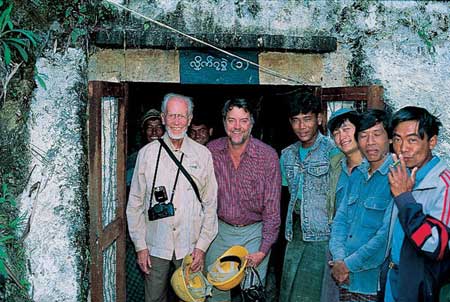 |
| Getting the shaft. Dr. Edward Gubelin with William Larson and a group of workers at the entrance to the Lin Yuang Chi ruby mine in Mogok, Burma during a 1993 visit. (Photo: Robert E. Kane, courtesy of Fine Gems International) |
The presentation is targeted at the basic-to-intermediate level:
Collector Bill Larson follows a fine tradition of a few noteworthy gem and mineral collectors such as Dr. Edward Gubelin, Dr. Peter Bancroft, and John Sinkankas whose collections have informed the industry and who were themselves inspiration for, and mentors to, Larson. In this session Larson discusses the collector’s impulse, how to build your own gem and mineral collection, and reveals some of his holdings while appreciating the import of other gem and mineral collectors.
This presentation will make a great companion piece to Jason Stephenson’s “Collecting and Investing in World Class Gemstones” featured in last month’s issue of Pala’s Gem News.
Seminar: Collectors of Gems and Minerals: How and Why
When: Saturday, February 7, 2009
Time: 1:00 – 2:00 p.m.
Where: AGTA GemFair, Maricopa Room, Tucson Convention Center
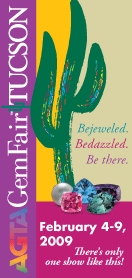 |
Other Tucson Highlights and Details
Next month, we’re looking forward to the world’s greatest gem and mineral show. Highlights include:
- Display of American Gem Trade Association Spectrum and Cutting Edge Awards winning collections
- Smithsonian Institution Special Exhibit: Highlights from the home of the Hope Diamond travel to the AGTA GemFair, along with Jeffrey Post, Ph.D., curator of the National Gem Collection
- The theme of this year’s Tucson Gem and Mineral Show is “Mineral Oddities”
See Pala International’s page on the Westward Look Show site.
Pala International will be represented in Tucson as follows.
Event: AGTA GemFair
When: February 4–9, 2009
Where: Tucson Convention Center
Booth: 1016–1018
Event: Westward Look Mineral Show
When: February 6–9, 2009
Where: Westward Look Resort
Suite: 236
Website: Official show website
Event: 55th Annual Tucson Gem and Mineral Show
When: February 12–15, 2009
Where: Tucson Convention Center
Booth: Aisle 5 East
We look forward to seeing our many friends there. Visit the Pala International Show Schedule for future events. [back to top]
Tucson Traffic Tips
Highway construction in Tucson will continue to impact travel. Use these resources to save yourself a headache.
[back to top]
Robert Weldon Takes Viewers on “Safari”
This Thursday, January 22, in Carlsbad, CA
 |
Acclaimed photographer Robert Weldon will present “A Photo-Safari to Gemstones of the World” this Thursday at 7:00 p.m. at the Sheraton Carlsbad. The seminar is cosponsored by the San Diego chapter of the Women’s Jewelry Association (WJA) and the Gemological Institute of America (GIA) Alumni Association.
According to the WJA website:
The Seminar will provide an overview of gem supplies as well as which gems will be popular at the upcoming Tucson trade shows in February. Weldon will also share his experiences and photographs from visiting different and far-reaching gemstone localities around the world.
Weldon is Manager, Photography & Visual Communications, GIA. The seminar is open to the public.
Event: “A Photo-Safari to Gemstones of the World”
When: Thursday, January 22, 2009, 7:00 p.m. sharp
Where: Sheraton Carlsbad, 5480 Grand Pacific Drive, Carlsbad, CA 92008
More Information: WJA website [back to top]
Pala International News
Pala’s Featured Stones: Rhodochrosite from a New Locality
Pala International obtained a parcel of rough rhodochrosite at November’s West Coast Gem & Mineral Show in Costa Mesa, from a locality that has yet to be confirmed. We will keep you posted as the mystery of origin unfolds.
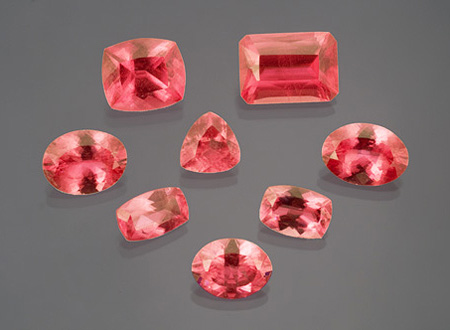 |
| Selection of the new rhodochrosite material; sizes ranging from 2.5 to 10.5 carats. (Photo: Mia Dixon) |
The material is the classic, beautiful pinkish-red hue, with more peach or orange secondary than some of the other rhodochrosite localities. Reminiscent of a padparadscha sapphire, with a pleasing blend of colors and a fluorescent glow. There are several localities around the world that produce rhodochrosite mineral specimens but there are really only two that produce facetable rough in quantity and quality: the Kalahari manganese fields of South Africa, and the Alma District of Park County in Colorado.
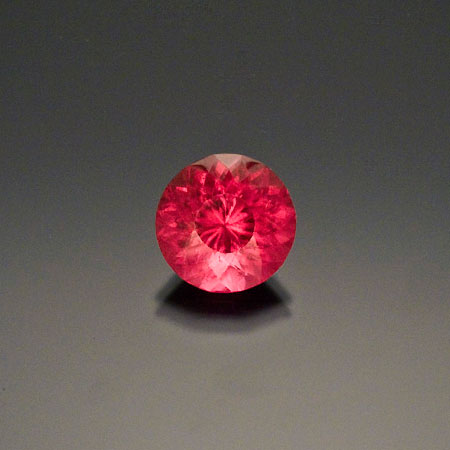 |
| Here is a fine example of what Colorado can produce: a 19.78-carat round brilliant, 16.8 mm in diameter. This stone has been sold. (Photo: Jason Stephenson) |
Displaying these three examples, you can see the unique variations of red produced by each deposit. Production from South Africa and Colorado is extremely limited; however, the new material is available now.
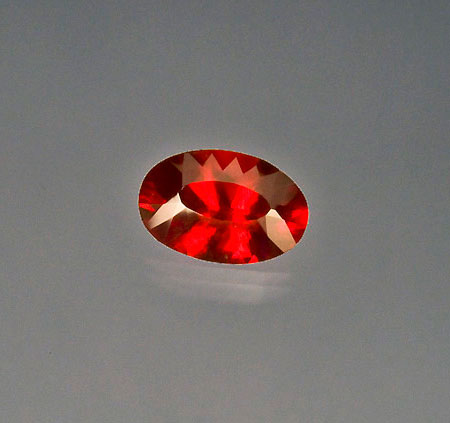 |
| Another example of a fine rhodochrosite, this time from South Africa: 16.27-carat oval brilliant, 20.21 x 13.41 mm. From the Gladnick collection. (Photo: Jason Stephenson) |
Also From Pala…
Collecting and Investing in World Class Gemstones
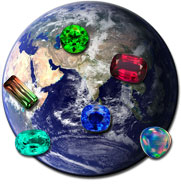 |
As we watch the world financial markets fall and lumber along the bottom, we begin to consider the question, Where did this money go? Even the most brilliant financial wizards probably have a difficult time explaining every last detail and the reasons why. With all these questions in the air about investments, in the parlance of our time, it may be worth researching other areas in which to invest capital. Most financial advisors will suggest that a percentage of one’s portfolio be in hard assets…
Pala International is endowed with some of the industry’s top consultants and specialists in the world of colored gemstones, with 40 years of observing and experiencing the gem and financial markets as they take their course. “Collecting and Investing in World Class Gemstones,” by Pala’s Jason Stephenson, is a reflection on that experience: a primer on the “pros” in favor of collecting—from the pros. [back to top]
Gem and Gemology News
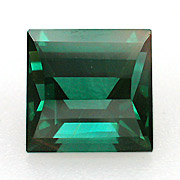 |
| Pala is withholding the sale of any feldspar-sunstones from our stock until it can be determined that they are in fact natural. The 2.88-carat piece above was sold to us as natural Tibetan material. (Photo: Wimon Manorotkul) |
Andesine Addition
SSEF’s Dr. Michael S. Krzemnicki Weighs In
We received the following note from Dr. Michael Krzemnicki, Deputy Director and Director of Education of SSEF Swiss Gemmological Institute, in response to last month’s discussion of red feldspar nomenclature by John S. White.
Interesting and very correct remark by John S. White: The intense red and green feldspars which I analysed in 2004 were also labradorites and not andesine.
Dr. Krzemnicki pointed us to this article on the subject: Krzemnicki M.S., “Red and green labradorite feldspar from Congo.” The Journal of Gemmology, Vol. 29 (2004), No. 1, pp. 15-23. [back to top]
The Maine Event
Tourmaline Necklace to Grace D.C. Gala
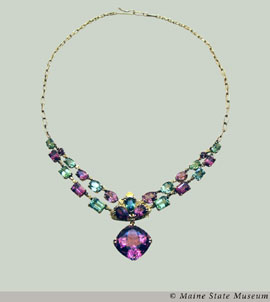 |
| Photo courtesy Maine State Museum. |
Maine’s first lady Karen Baldacci will attend presidential inaugural events adorned with the Maine Tourmaline Necklace, which contains 52 carats of pink, green, and blue-green tourmaline from the Dunton quarry in Newry. The necklace features gold panned from the Swift River in Oxford County as well as a dangling 24-carat pink tourmaline centerpiece.
The necklace was presented to the state in 1977 with the provision that Maine’s first ladies would wear it on official state occasions.
According to the Bangor Daily News, a book about the necklace, The Crown Jewels of Maine, has recently been published by one of the piece’s creators, jeweler Jim Vose. More information also is available from the Main State Museum. [back to top]
Industry News
Burma Bits
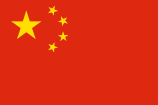 |
Foreign Investment in Burma Nearly Doubles
Last month we noted that jade markets in China had stagnated, due apparently to the U.S. ban on Burma jade.
Nonetheless, total investment in Burma by China soared during the first nine months of 2008, according to statistics published by Burma’s Central Statistical Organization, and reported by Associated Press on January 5. (In November we linked to an Irrawaddy story that reported trade between the two countries grew in FY2007–08 by 60 percent.)
The foreign investment increase is mainly in the mining sector. Overall foreign investment nearly doubled (from $502.5 to $974.9), compared with the same nine months last year. [back to top]
Six New Gem Mining Blocks Leased
400+ Jade Blocks Created After Beijing Olympics
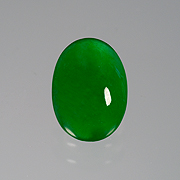 |
| This jadeite oval from Burma features lovely translucency and an even color. And, of course, it’s available. (Photo: Wimon Manorotkul) |
Burma’s Ministry of Mines announced the allocation of six gem mining blocks to local entrepreneurs with ties to the country’s rulers, according to a January 14 story by Mizzima News (MN). The blocks are located in Shan and Kachin states, and Sagaing division in the north and eastern regions of the country.
A November 24 Kachin News Group (KNG) story stated that
[s]oon after China's Beijing Olympic Games in August, the Ministry of Mines under of the Burmese ruling junta created more than 400 new jade mining blocks in Hpakant, Lonkin (Lawng Hkang) and Taw Maw, according to ethnic Kachin jade merchants in Hpakant.
While operation of jade blocks is granted only by approval of ruling authorities, and then mainly to “private” companies allied with the rulers, the KNG story explains an alternative jade mining system, Naing-ngan-daw Akyoto, or “mutual benefit” (as in benefit between company and authorities). Begun in 2005 in Phakant, the system offers block operation for a small mining permission fee and a 40-percent tax for each sale.
The MN story mentions changes seen in the local gem markets of Mogok and Phakant. With the advance of mechanized mining, controlled by select enterprises, the finest rubies and jade now bypass the local traders, moving across borders or to official auctions. The article quotes a “long time jade businessman in Mandalay” as saying that the country’s rulers are earning more from cross-border trade than from auctions, the latest of which was held earlier this month.
Jade Mining Heedless of Global Economy, Sanctions
The November 24 KNG article claimed that jade mining in Phakant (aka Hpakant) resumed in October, after a break in the monsoons, as if the world economic crisis and U.S. sanctions hadn’t occurred in the meantime.
Gemstone material is declining in quality and quantity, according to an unnamed “retired professor from the Rangoon Institute of Economics” quoted in Mizzima News on January 11. To illustrate the point, the article compares FY2007–08 production with 2004–05 (ruby) and 2003–04 (sapphire), which are down considerably, but as we reported last month, production of jade, ruby, and sapphire is up by at least a third for the first nine calendar months of 2008.
The KNG article included an estimate of $400 million in foreign exchange from Phakant (aka Hpakant) jade in 2007. See our Burma Gem Sales and Statistics for the latest available data. [back to top]
New Year’s Eve Jade Mine Explosion Kills Two in Phakant
Two miners were killed and seven injured in an underground jade mine in Phakant (aka Hpakant), in the northern state of Kachin, the afternoon of December 31, as reported by Kachin News Group (KNG) on January 7. The mine is run around the clock, according to the story, by “300 miners including overseers, 20 power shovels and about fifty 12-wheel rock trucks.”
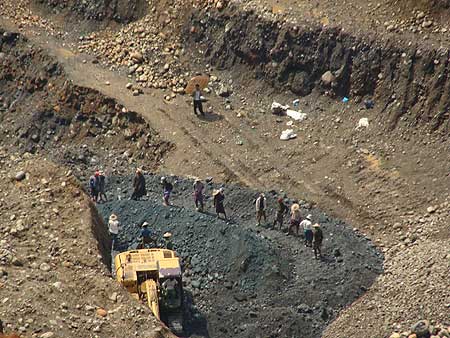 |
| Jade mining at Phakant, in Kachin state. (Photo courtesy All Kachin Student and Youth Union) |
The article’s sources claimed that the mining operations “are operated by Chinese jade businessmen.” The story discussed the state of the jade trade:
At present jade markets are cold in China and with [the] U.S. ban on importing gem[s] from Burma, most small jade companies have stopped mining but only some jade companies linked with drug smuggling can continue mining, said sources close to jade companies in Hpakant.
KNG also reported on January 2 about a toll being collected on the Mogaung–Hpakant jade mining road. The road, currently being reconstructed, isn’t set to be completed for three years. [back to top]
Bite-Sized Bits
- The Irrawaddy: Burma’s head of state has his own likeness carved on a jade (?) Buddha statue
- Mizzima News: Gems tycoon Zaw Zaw has assets frozen by U.S.
- Xinhua News Agency: 46th Gems Emporium to be held in March
- Yangon City: The 26th Gems & Jade Sales 2009 was held January 5–9, but no sales data available
- Yangon City: An exclusive pearl exhibition for domestic dealers was held for three days during the second week of December; no sales data available [back to top]
Books
Ancient and Modern Gems and Jewels
In the Collection of Her Majesty The Queen
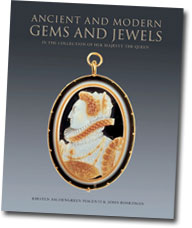 |
The Royal Collection Publications, an arm of the trust that oversees the treasures of the British royal family, is publishing a monograph devoted to the gemstones in the collection of reigning monarch, Elizabeth II.
From the press release:
The Royal Collection includes historic gems and jewels of outstanding quality. The Claudius cameo, the Darnley jewel, the “Henry VIII” hat badge and the group of sixteenth- and seventeenth-century cameos and intaglios are as fine as any to be found in the royal and princely collections of Europe.
A unique combination of chance and royal taste has given this important part of the Royal Collection its particular character. The 327 cameos, intaglios, jewels and signed Orders cover over 2,000 years of jewelry history and clearly reflect the differing tastes of their previous owners.
Extensive research in contemporary account books and inventories has produced much new information on the history of individual gems and jewels. This major catalog brings together the conclusions of two leading historians and offers not only a visual record of the appearance of every piece, but also an insight into the delicate art of hardstone carving.
The book is distributed by the Antique Collectors’ Club. [back to top]
Ian Balfour’s Famous Diamonds – A New Edition
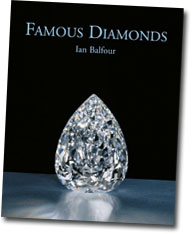 |
Also from the Antique Collectors’ Club, what appears to be the fifth edition of Ian Balfour’s Famous Diamonds. Balfour, who spent decades in the diamond industry, takes the reader through the stories and histories behind nearly 80 world-class diamonds, and forty more notable stones. The book includes over 200 photographs.
At the time of the first edition’s publication in 1987, the late Richard T. Liddicoat wrote in the journal Gems & Gemology of Balfour’s classic: “No one… has written as entertainingly, nor researched so exhaustively to present complete stories, as has Ian Balfour.” [back to top]
— End January Newsletter • Published 1/19/09 —
Note: Palagems.com selects much of its material in the interest of fostering a stimulating discourse on the topics of gems, gemology, and the gemstone industry. Therefore the opinions expressed here are not necessarily those held by the proprietors of Palagems.com. We welcome your feedback.
